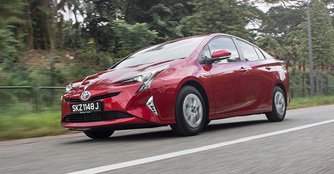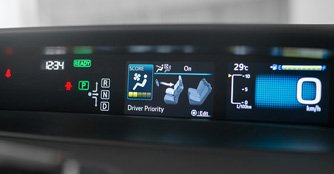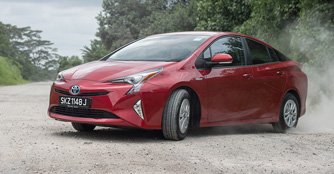Toyota Prius Hybrid 1.8 (A) Review
24 Mar 2016|65,794 views
Hybrid cars have always had a slightly oddball reputation. On one hand, you have cars like the older generation Toyota Prius, the poster child for the tree-hugging crowd that took the petroleum-dependent world by storm. It revolutionised the fuel efficiency game, sacrificing driving dynamics for a significantly more practical, economical and green vehicle.
On the other hand, you have cars like the Ferrari LaFerrari, the McLaren P1 and the Porsche 918, which have similarly embraced hybrid technology, but utilised it in a different way to produce hypercar performance whilst still conforming to emission regulations.
Either way, hybrids have never been what many would consider as 'typical' or 'normal' cars. These cars have straddled two extremes on the spectrum, and in terms of the driving experience, offers arguably either too little or too much.
But with the new Toyota Prius, it's out to change all of that.
Exterior
The accusations of hybrids of the past having little character and the personality of an accountant are harsh, but not entirely unjustified. Taxis are probably the first thing that come to mind when thinking about Priuses on Singapore roads.
On the other hand, you have cars like the Ferrari LaFerrari, the McLaren P1 and the Porsche 918, which have similarly embraced hybrid technology, but utilised it in a different way to produce hypercar performance whilst still conforming to emission regulations.
Either way, hybrids have never been what many would consider as 'typical' or 'normal' cars. These cars have straddled two extremes on the spectrum, and in terms of the driving experience, offers arguably either too little or too much.
But with the new Toyota Prius, it's out to change all of that.
Exterior
The accusations of hybrids of the past having little character and the personality of an accountant are harsh, but not entirely unjustified. Taxis are probably the first thing that come to mind when thinking about Priuses on Singapore roads.
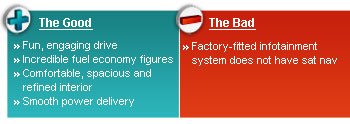 |
The new Prius takes bold steps to advance its exterior looks. The front end is sharper, taking inspiration from the radical Mirai, Toyota's hydrogen fuel-cell car. The overall body shape hasn't drastically changed, but some nip and tuck mean that the new Prius looks sleeker and more coupe-like. The roof position has also been shifted forward to create a more coupe-like silhouette.
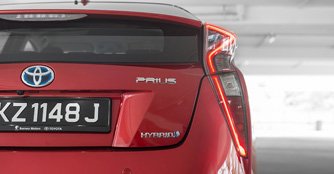
The most significant change is at the rear. The rear lights are a dramatic boomerang that is definitely a head-turner, especially at night.
While it may not immediately strike you as a good-looking car, the new Prius definitely grows on you. The changes to the exterior mean that it looks and feels tauter, sharper and more futuristic, moving forward from its more box-ish predecessor. But perhaps most importantly, it imparts a sense of drama - a tantalising taste of things to come.
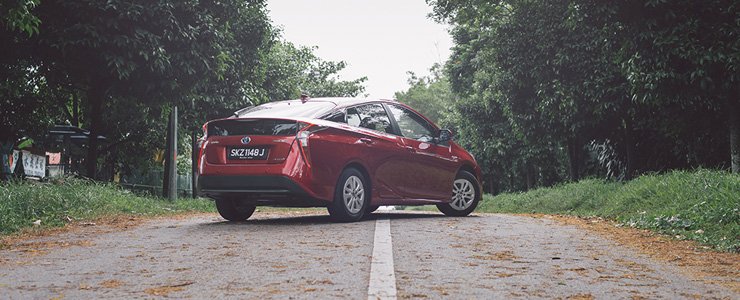 |
Interior
The changes to the interior are more evolutionary than revolutionary. Seven years on from its predecessor, the new Prius definitely looks and feels up to trend. The interior is spacious, well-built, and exhibits a good level of refinement all round.
Comfort has also been improved, especially in terms of ergonomics. All the functions on the tidied up centre console are well-positioned and easy to reach, and a redesigned steering wheel means that most of these operations can be operated by the steering wheel-mounted buttons.
The Prius also has a unique smart air-conditioning system that uses sensors to detect where passengers are seated, which then automatically directs air flow there. Conversely, it will turn off the back row air-con when no rear passengers are on board, which helps to save energy.
The changes to the interior are more evolutionary than revolutionary. Seven years on from its predecessor, the new Prius definitely looks and feels up to trend. The interior is spacious, well-built, and exhibits a good level of refinement all round.
Comfort has also been improved, especially in terms of ergonomics. All the functions on the tidied up centre console are well-positioned and easy to reach, and a redesigned steering wheel means that most of these operations can be operated by the steering wheel-mounted buttons.
The Prius also has a unique smart air-conditioning system that uses sensors to detect where passengers are seated, which then automatically directs air flow there. Conversely, it will turn off the back row air-con when no rear passengers are on board, which helps to save energy.
The futuristic dashboard also offers up a glut of information - from how the drivetrain is presently functioning to a scoring function that lets you feel better about how many polar bears you have saved based on how light-footed you are with the throttle.
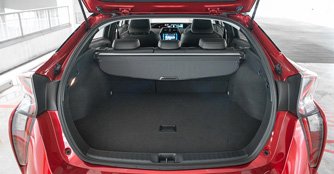
 Boot space has been expanded by 56 litres to 502 litres, thanks to the batteries being relocated to under the seats
Boot space has been expanded by 56 litres to 502 litres, thanks to the batteries being relocated to under the seats
There are some gripes with the car's interior though. The factory-fitted infotainment system does not come with sat nav, which strikes us as a strange decision considering that just about every car these days comes equipped with it. In addition, a couple of the plastic parts are unnecessarily painted white - needlessly showy in an otherwise subdued and excellent interior.
The gear knob also takes some getting used to, both in terms of its location and its functionality, such as the 'Park' function being a separate button from the gear knob.

There are some gripes with the car's interior though. The factory-fitted infotainment system does not come with sat nav, which strikes us as a strange decision considering that just about every car these days comes equipped with it. In addition, a couple of the plastic parts are unnecessarily painted white - needlessly showy in an otherwise subdued and excellent interior.
The gear knob also takes some getting used to, both in terms of its location and its functionality, such as the 'Park' function being a separate button from the gear knob.
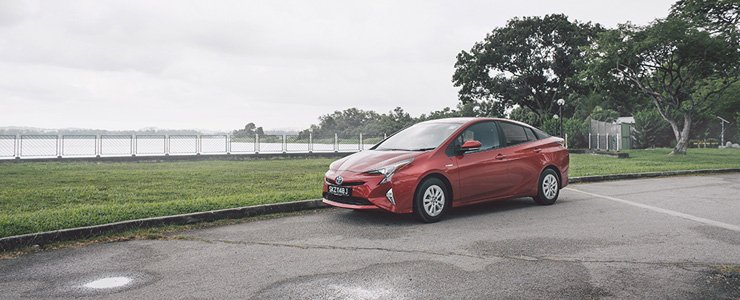 |
The Drive
It is here where the new Prius packs the most surprises. Built on the Toyota New Global Architecture (TNGA), the new Prius has been engineered with a focus on the driving experience, as highlighted by its Chief Engineer, Koji Toyoshima. The promise of both improved driving dynamics and fuel efficiency is a bold one, but one that Toyota has remarkably achieved.
The new Prius bucks the expectation of hybrids being uninspired machines. Power delivery is delightfully smooth, and the transition between electric and petrol power is seamless, meaning that it is easy to forget one is driving a hybrid. While the Prius doesn't necessarily score high on outright power and performance, it offers excellent usable power, more than capable of highway overtaking manoeuvres and the occasional hoonish acceleration.
It also handles itself remarkably well on bendy roads, which meant a fair amount of whooping and cheering whilst we were test driving the car. The chassis is taut, holding true through corners with minimal roll, and capable of more drama than we initially thought possible.
The new Prius also proved to be remarkably composed on our roads. The suspension setup is well-balanced between being comfortable and firm, making the car really tenable across all situations. It does an excellent job of soaking up bumps and imperfections in the road, while continuing to feel planted on the ground.
It is here where the new Prius packs the most surprises. Built on the Toyota New Global Architecture (TNGA), the new Prius has been engineered with a focus on the driving experience, as highlighted by its Chief Engineer, Koji Toyoshima. The promise of both improved driving dynamics and fuel efficiency is a bold one, but one that Toyota has remarkably achieved.
The new Prius bucks the expectation of hybrids being uninspired machines. Power delivery is delightfully smooth, and the transition between electric and petrol power is seamless, meaning that it is easy to forget one is driving a hybrid. While the Prius doesn't necessarily score high on outright power and performance, it offers excellent usable power, more than capable of highway overtaking manoeuvres and the occasional hoonish acceleration.
It also handles itself remarkably well on bendy roads, which meant a fair amount of whooping and cheering whilst we were test driving the car. The chassis is taut, holding true through corners with minimal roll, and capable of more drama than we initially thought possible.
The new Prius also proved to be remarkably composed on our roads. The suspension setup is well-balanced between being comfortable and firm, making the car really tenable across all situations. It does an excellent job of soaking up bumps and imperfections in the road, while continuing to feel planted on the ground.
Fuel efficiency - the Prius' calling card - has been improved as well. The new model boasts a 27km/L figure, a number that you can get close to without having to try very hard. A scoring system for acceleration, cruising and braking means that there is a game-like mission to achieve that remarkable figure, too.
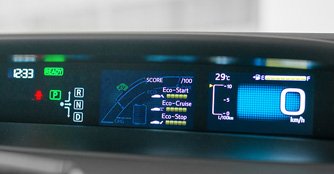
 The Prius will rate each drive over a score of 100, posing a challenge that some may find rather exciting
The Prius will rate each drive over a score of 100, posing a challenge that some may find rather exciting
Conclusion
Hybrids have had a divisive reputation. Some purists may slam it as the devil's spawn, killing the essence of the mechanical car in favour of emissions chasing and polar bear-saving. Others may see it as the holy grail of performance, offering an innovative way to achieve hypercar performance.
As we spent more time with the new Prius, it becomes increasingly hard to find a reason to not want it. Once you can get over the unsavoury reputation of hybrid cars (and the association of the Prius with taxis), you'll realise that the Prius makes sense in just about every way.
The Prius has managed to achieve many things. It offers good driving dynamics and handling, with usable everyday performance, whilst still maintaining outlandish fuel economy figures. It manages to be highly practical, with an ample boot and interior space that will comfortably fit a family of five. And it's a fairly good-looking car to boot.
But above all, the new Toyota Prius will undoubtedly be the car that leads the hybrid pack. And that may be its greatest achievement of all.

Conclusion
Hybrids have had a divisive reputation. Some purists may slam it as the devil's spawn, killing the essence of the mechanical car in favour of emissions chasing and polar bear-saving. Others may see it as the holy grail of performance, offering an innovative way to achieve hypercar performance.
As we spent more time with the new Prius, it becomes increasingly hard to find a reason to not want it. Once you can get over the unsavoury reputation of hybrid cars (and the association of the Prius with taxis), you'll realise that the Prius makes sense in just about every way.
The Prius has managed to achieve many things. It offers good driving dynamics and handling, with usable everyday performance, whilst still maintaining outlandish fuel economy figures. It manages to be highly practical, with an ample boot and interior space that will comfortably fit a family of five. And it's a fairly good-looking car to boot.
But above all, the new Toyota Prius will undoubtedly be the car that leads the hybrid pack. And that may be its greatest achievement of all.
Hybrid cars have always had a slightly oddball reputation. On one hand, you have cars like the older generation Toyota Prius, the poster child for the tree-hugging crowd that took the petroleum-dependent world by storm. It revolutionised the fuel efficiency game, sacrificing driving dynamics for a significantly more practical, economical and green vehicle.
On the other hand, you have cars like the Ferrari LaFerrari, the McLaren P1 and the Porsche 918, which have similarly embraced hybrid technology, but utilised it in a different way to produce hypercar performance whilst still conforming to emission regulations.
Either way, hybrids have never been what many would consider as 'typical' or 'normal' cars. These cars have straddled two extremes on the spectrum, and in terms of the driving experience, offers arguably either too little or too much.
But with the new Toyota Prius, it's out to change all of that.Exterior
The accusations of hybrids of the past having little character and the personality of an accountant are harsh, but not entirely unjustified. Taxis are probably the first thing that come to mind when thinking about Priuses on Singapore roads.
On the other hand, you have cars like the Ferrari LaFerrari, the McLaren P1 and the Porsche 918, which have similarly embraced hybrid technology, but utilised it in a different way to produce hypercar performance whilst still conforming to emission regulations.
Either way, hybrids have never been what many would consider as 'typical' or 'normal' cars. These cars have straddled two extremes on the spectrum, and in terms of the driving experience, offers arguably either too little or too much.
But with the new Toyota Prius, it's out to change all of that.Exterior
The accusations of hybrids of the past having little character and the personality of an accountant are harsh, but not entirely unjustified. Taxis are probably the first thing that come to mind when thinking about Priuses on Singapore roads.
The new Prius takes bold steps to advance its exterior looks. The front end is sharper, taking inspiration from the radical Mirai, Toyota's hydrogen fuel-cell car. The overall body shape hasn't drastically changed, but some nip and tuck mean that the new Prius looks sleeker and more coupe-like. The roof position has also been shifted forward to create a more coupe-like silhouette.
The most significant change is at the rear. The rear lights are a dramatic boomerang that is definitely a head-turner, especially at night.
While it may not immediately strike you as a good-looking car, the new Prius definitely grows on you. The changes to the exterior mean that it looks and feels tauter, sharper and more futuristic, moving forward from its more box-ish predecessor. But perhaps most importantly, it imparts a sense of drama - a tantalising taste of things to come.
The most significant change is at the rear. The rear lights are a dramatic boomerang that is definitely a head-turner, especially at night.
While it may not immediately strike you as a good-looking car, the new Prius definitely grows on you. The changes to the exterior mean that it looks and feels tauter, sharper and more futuristic, moving forward from its more box-ish predecessor. But perhaps most importantly, it imparts a sense of drama - a tantalising taste of things to come.
Interior
The changes to the interior are more evolutionary than revolutionary. Seven years on from its predecessor, the new Prius definitely looks and feels up to trend. The interior is spacious, well-built, and exhibits a good level of refinement all round.
Comfort has also been improved, especially in terms of ergonomics. All the functions on the tidied up centre console are well-positioned and easy to reach, and a redesigned steering wheel means that most of these operations can be operated by the steering wheel-mounted buttons.
The Prius also has a unique smart air-conditioning system that uses sensors to detect where passengers are seated, which then automatically directs air flow there. Conversely, it will turn off the back row air-con when no rear passengers are on board, which helps to save energy.
The changes to the interior are more evolutionary than revolutionary. Seven years on from its predecessor, the new Prius definitely looks and feels up to trend. The interior is spacious, well-built, and exhibits a good level of refinement all round.
Comfort has also been improved, especially in terms of ergonomics. All the functions on the tidied up centre console are well-positioned and easy to reach, and a redesigned steering wheel means that most of these operations can be operated by the steering wheel-mounted buttons.
The Prius also has a unique smart air-conditioning system that uses sensors to detect where passengers are seated, which then automatically directs air flow there. Conversely, it will turn off the back row air-con when no rear passengers are on board, which helps to save energy.
The futuristic dashboard also offers up a glut of information - from how the drivetrain is presently functioning to a scoring function that lets you feel better about how many polar bears you have saved based on how light-footed you are with the throttle.
There are some gripes with the car's interior though. The factory-fitted infotainment system does not come with sat nav, which strikes us as a strange decision considering that just about every car these days comes equipped with it. In addition, a couple of the plastic parts are unnecessarily painted white - needlessly showy in an otherwise subdued and excellent interior.
The gear knob also takes some getting used to, both in terms of its location and its functionality, such as the 'Park' function being a separate button from the gear knob.
There are some gripes with the car's interior though. The factory-fitted infotainment system does not come with sat nav, which strikes us as a strange decision considering that just about every car these days comes equipped with it. In addition, a couple of the plastic parts are unnecessarily painted white - needlessly showy in an otherwise subdued and excellent interior.
The gear knob also takes some getting used to, both in terms of its location and its functionality, such as the 'Park' function being a separate button from the gear knob.
The Drive
It is here where the new Prius packs the most surprises. Built on the Toyota New Global Architecture (TNGA), the new Prius has been engineered with a focus on the driving experience, as highlighted by its Chief Engineer, Koji Toyoshima. The promise of both improved driving dynamics and fuel efficiency is a bold one, but one that Toyota has remarkably achieved.
The new Prius bucks the expectation of hybrids being uninspired machines. Power delivery is delightfully smooth, and the transition between electric and petrol power is seamless, meaning that it is easy to forget one is driving a hybrid. While the Prius doesn't necessarily score high on outright power and performance, it offers excellent usable power, more than capable of highway overtaking manoeuvres and the occasional hoonish acceleration.
It also handles itself remarkably well on bendy roads, which meant a fair amount of whooping and cheering whilst we were test driving the car. The chassis is taut, holding true through corners with minimal roll, and capable of more drama than we initially thought possible.
The new Prius also proved to be remarkably composed on our roads. The suspension setup is well-balanced between being comfortable and firm, making the car really tenable across all situations. It does an excellent job of soaking up bumps and imperfections in the road, while continuing to feel planted on the ground.
Fuel efficiency - the Prius' calling card - has been improved as well. The new model boasts a 27km/L figure, a number that you can get close to without having to try very hard. A scoring system for acceleration, cruising and braking means that there is a game-like mission to achieve that remarkable figure, too.
Conclusion
Hybrids have had a divisive reputation. Some purists may slam it as the devil's spawn, killing the essence of the mechanical car in favour of emissions chasing and polar bear-saving. Others may see it as the holy grail of performance, offering an innovative way to achieve hypercar performance.
As we spent more time with the new Prius, it becomes increasingly hard to find a reason to not want it. Once you can get over the unsavoury reputation of hybrid cars (and the association of the Prius with taxis), you'll realise that the Prius makes sense in just about every way.
The Prius has managed to achieve many things. It offers good driving dynamics and handling, with usable everyday performance, whilst still maintaining outlandish fuel economy figures. It manages to be highly practical, with an ample boot and interior space that will comfortably fit a family of five. And it's a fairly good-looking car to boot.
But above all, the new Toyota Prius will undoubtedly be the car that leads the hybrid pack. And that may be its greatest achievement of all.
Conclusion
Hybrids have had a divisive reputation. Some purists may slam it as the devil's spawn, killing the essence of the mechanical car in favour of emissions chasing and polar bear-saving. Others may see it as the holy grail of performance, offering an innovative way to achieve hypercar performance.
As we spent more time with the new Prius, it becomes increasingly hard to find a reason to not want it. Once you can get over the unsavoury reputation of hybrid cars (and the association of the Prius with taxis), you'll realise that the Prius makes sense in just about every way.
The Prius has managed to achieve many things. It offers good driving dynamics and handling, with usable everyday performance, whilst still maintaining outlandish fuel economy figures. It manages to be highly practical, with an ample boot and interior space that will comfortably fit a family of five. And it's a fairly good-looking car to boot.
But above all, the new Toyota Prius will undoubtedly be the car that leads the hybrid pack. And that may be its greatest achievement of all.
Also read our comparison article on:
Hyundai Ioniq Hybrid 1.6 GLS vs Toyota Prius Hybrid 1.8Car Information
Toyota Prius Hybrid 1.8 (A)
CAT B|Petrol-Electric|27km/L
Horsepower
90kW (121 bhp)
Torque
142 Nm
Acceleration
-
This model is no longer being sold by local distributor
All Used Toyota Prius HybridThank You For Your Subscription.

































